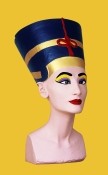Hans-Peter Feldmann
06 Dec 2012 - 06 Jan 2013

Hans-Peter Feldmann
The Bust of Nefertiti, 2012
Plaster, painted, 45 cm
© VG Bild-Kunst, Bonn 2012 / Foto: Joseph Sappler
The Bust of Nefertiti, 2012
Plaster, painted, 45 cm
© VG Bild-Kunst, Bonn 2012 / Foto: Joseph Sappler
HANS-PETER FELDMANN
The Bust of Nefertiti
6 December 2012 - 6 January 2013
From 6th December 2012 to 6th January 2013, the Düsseldorf-based artist Hans-Peter Feldmann shows his perspective on the spectacular sculpture of Queen Nefertiti with a work especially designed for the Nationalgalerie (National Gallery). This presentation complements, for the first four weeks, the exhibition 'In the Light of Amarna. 100 Years of the Nefertiti Discovery' to be presented at the Neue Museum (New Museum).
On 6th December 1912, the bust of Queen Nefertiti was discovered in the ruins of the ancient Egyptian city of Achetaton (today's Tell el-Amarna). On the occasion of the centenary of this date, the Ägyptische Museum (Egyptian Museum) of the Staatliche Museen zu Berlin (National Museums in Berlin) devotes a comprehensive exhibition on Museum Island not only to the famous bust, but to the entire Amarna Period.
Hans-Peter Feldmann, in turn, uses the 100th anniversary of the discovery to emphasize the history of the staging of the bust from an archaeological find to a commercially exploited ideal of beauty, thereby providing a contemporary interpretation of the highlight of Berlin's Museum Island in Mies van der Rohe's 'Temple of Art'.
Since the 1970s, the artist, born in 1941, has been working on the effect of images and objects, the shift of meanings and the overcoming of traditional confines of art. His version of Nefertiti, created in 2012 and now on display in the upper hall of the Neue Nationalgalerie, represents his own confrontation with the 'Beautiful One' (Neferet-iti: literally, 'the beauty is come'). With the use of stridently brash colours, Feldmann satirises a wide range of themes: supposedly blind to the gracefulness and delicate design of the celebrated original, he jumbles up art terms and questions in a tongue-in-cheek way what happens when, unauthorized additions are being made, the ancient is brought up to date and the familiar de-contextualised. In contrast to the original, Feldmann's 'enhanced' version of Nefertiti looks at the viewer with two eyes, while the addition of a beauty spot and the garish make-up project present-day elements of everyday and party culture onto the object.
The artist uses Nefertiti to address both the interface between high and amateur art and the possibilities of the individual to participate in the existing history of art and culture. This process reveals not only Feldmann's joy in copying and unashamed appropriation, but also the search for concepts of universal beauty and subjectivity.
'The Bust of Nefertiti' at the Neue Nationalgalerie represents the latest offering in Hans-Peter Feldmann's 'Antikenserie'. In this series, the artist enters into a dialogue with the past, using existing objects. The plastercast of the Nefertiti which is shown on its own at the Neue Nationalgalerie, is based on a detailed scan of the original bust. This series includes amongst others Michelangelo's David and the Venus de Milo.
The Bust of Nefertiti
6 December 2012 - 6 January 2013
From 6th December 2012 to 6th January 2013, the Düsseldorf-based artist Hans-Peter Feldmann shows his perspective on the spectacular sculpture of Queen Nefertiti with a work especially designed for the Nationalgalerie (National Gallery). This presentation complements, for the first four weeks, the exhibition 'In the Light of Amarna. 100 Years of the Nefertiti Discovery' to be presented at the Neue Museum (New Museum).
On 6th December 1912, the bust of Queen Nefertiti was discovered in the ruins of the ancient Egyptian city of Achetaton (today's Tell el-Amarna). On the occasion of the centenary of this date, the Ägyptische Museum (Egyptian Museum) of the Staatliche Museen zu Berlin (National Museums in Berlin) devotes a comprehensive exhibition on Museum Island not only to the famous bust, but to the entire Amarna Period.
Hans-Peter Feldmann, in turn, uses the 100th anniversary of the discovery to emphasize the history of the staging of the bust from an archaeological find to a commercially exploited ideal of beauty, thereby providing a contemporary interpretation of the highlight of Berlin's Museum Island in Mies van der Rohe's 'Temple of Art'.
Since the 1970s, the artist, born in 1941, has been working on the effect of images and objects, the shift of meanings and the overcoming of traditional confines of art. His version of Nefertiti, created in 2012 and now on display in the upper hall of the Neue Nationalgalerie, represents his own confrontation with the 'Beautiful One' (Neferet-iti: literally, 'the beauty is come'). With the use of stridently brash colours, Feldmann satirises a wide range of themes: supposedly blind to the gracefulness and delicate design of the celebrated original, he jumbles up art terms and questions in a tongue-in-cheek way what happens when, unauthorized additions are being made, the ancient is brought up to date and the familiar de-contextualised. In contrast to the original, Feldmann's 'enhanced' version of Nefertiti looks at the viewer with two eyes, while the addition of a beauty spot and the garish make-up project present-day elements of everyday and party culture onto the object.
The artist uses Nefertiti to address both the interface between high and amateur art and the possibilities of the individual to participate in the existing history of art and culture. This process reveals not only Feldmann's joy in copying and unashamed appropriation, but also the search for concepts of universal beauty and subjectivity.
'The Bust of Nefertiti' at the Neue Nationalgalerie represents the latest offering in Hans-Peter Feldmann's 'Antikenserie'. In this series, the artist enters into a dialogue with the past, using existing objects. The plastercast of the Nefertiti which is shown on its own at the Neue Nationalgalerie, is based on a detailed scan of the original bust. This series includes amongst others Michelangelo's David and the Venus de Milo.
